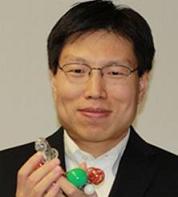Protein-Hydrogel Combo May Help Heal Heart
The new strategy combines two experimental techniques for reviving heart tissue after a heart attack.

As reported by Prachi Patel of the American Chemical Society’s Chemical and Engineering News, the new strategy to restore damaged cardiac muscle from heart attacks combines a tissue-growing protein with a strengthening gel. Even if a person survives a heart attack, the lack of blood flow damages tissue, which often leads to heart failure. Now
McGowan Institute for Regenerative Medicine affiliated faculty member Yadong Wang, PhD (pictured), the William Kepler Whiteford Professor in Bioengineering with adjunct positions in Chemical Engineering, Mechanical Engineering and Materials Science, and Surgery at the University of Pittsburgh, and researchers have developed a mixture of a growth protein and a biodegradable gel to prevent scarring and repair injured heart muscle. When injected at the site of a heart attack in pre-clinical trials, the cocktail limited cardiac tissue damage, the team reports.
The new strategy combines two experimental techniques for reviving heart tissue after a heart attack. One approach is to inject a scaffolding material to reinforce the weakened muscle wall. Another is to inject stem cells or growth factors to help repair the damaged tissue. On their own, these individual methods have shown limited success in clinical trials.
Injected growth factors show some promise, says Dr. Wang, but they quickly break down or diffuse out of cardiac tissue.
So Dr. Wang and colleagues devised a special trick to deliver a growth protein trapped within a hydrogel. The gel protects the protein, keeps it at the heart attack site, and supports the damaged walls of the heart right after a heart attack. They used a tissue-signaling protein called Sonic hedgehog that is known to protect cardiac cells and help them grow by inducing the formation of blood vessels.
The researchers mixed it with negatively charged heparin, which is a widely used anticoagulant, and a polycation, which attaches to the oppositely charged heparin molecules to form micrometer-sized liquid droplets.
Next, they combined the droplets with a polyethylene glycol gel. The gel targets the signaling protein to damaged tissue, Dr. Wang says, because it degrades in the presence of an inflammatory enzyme secreted after a heart attack.
If the material shows success in humans, Dr. Wang imagines that doctors could deliver it using a catheter or through a small opening in the chest wall.
Illustration: McGowan Institute for Regenerative Medicine.
Read more…
Chemical and Engineering News (08/19/15)
Bio: Dr. Yadong Wang
Abstract (ACS Biomaterials Science and Engineering; July 30, 2015.)
The new strategy combines two experimental techniques for reviving heart tissue after a heart attack. One approach is to inject a scaffolding material to reinforce the weakened muscle wall. Another is to inject stem cells or growth factors to help repair the damaged tissue. On their own, these individual methods have shown limited success in clinical trials.
Injected growth factors show some promise, says Dr. Wang, but they quickly break down or diffuse out of cardiac tissue.
So Dr. Wang and colleagues devised a special trick to deliver a growth protein trapped within a hydrogel. The gel protects the protein, keeps it at the heart attack site, and supports the damaged walls of the heart right after a heart attack. They used a tissue-signaling protein called Sonic hedgehog that is known to protect cardiac cells and help them grow by inducing the formation of blood vessels.
The researchers mixed it with negatively charged heparin, which is a widely used anticoagulant, and a polycation, which attaches to the oppositely charged heparin molecules to form micrometer-sized liquid droplets.
Next, they combined the droplets with a polyethylene glycol gel. The gel targets the signaling protein to damaged tissue, Dr. Wang says, because it degrades in the presence of an inflammatory enzyme secreted after a heart attack.
If the material shows success in humans, Dr. Wang imagines that doctors could deliver it using a catheter or through a small opening in the chest wall.
Illustration: McGowan Institute for Regenerative Medicine.
Read more…
Chemical and Engineering News (08/19/15)
Bio: Dr. Yadong Wang
Abstract (ACS Biomaterials Science and Engineering; July 30, 2015.)
